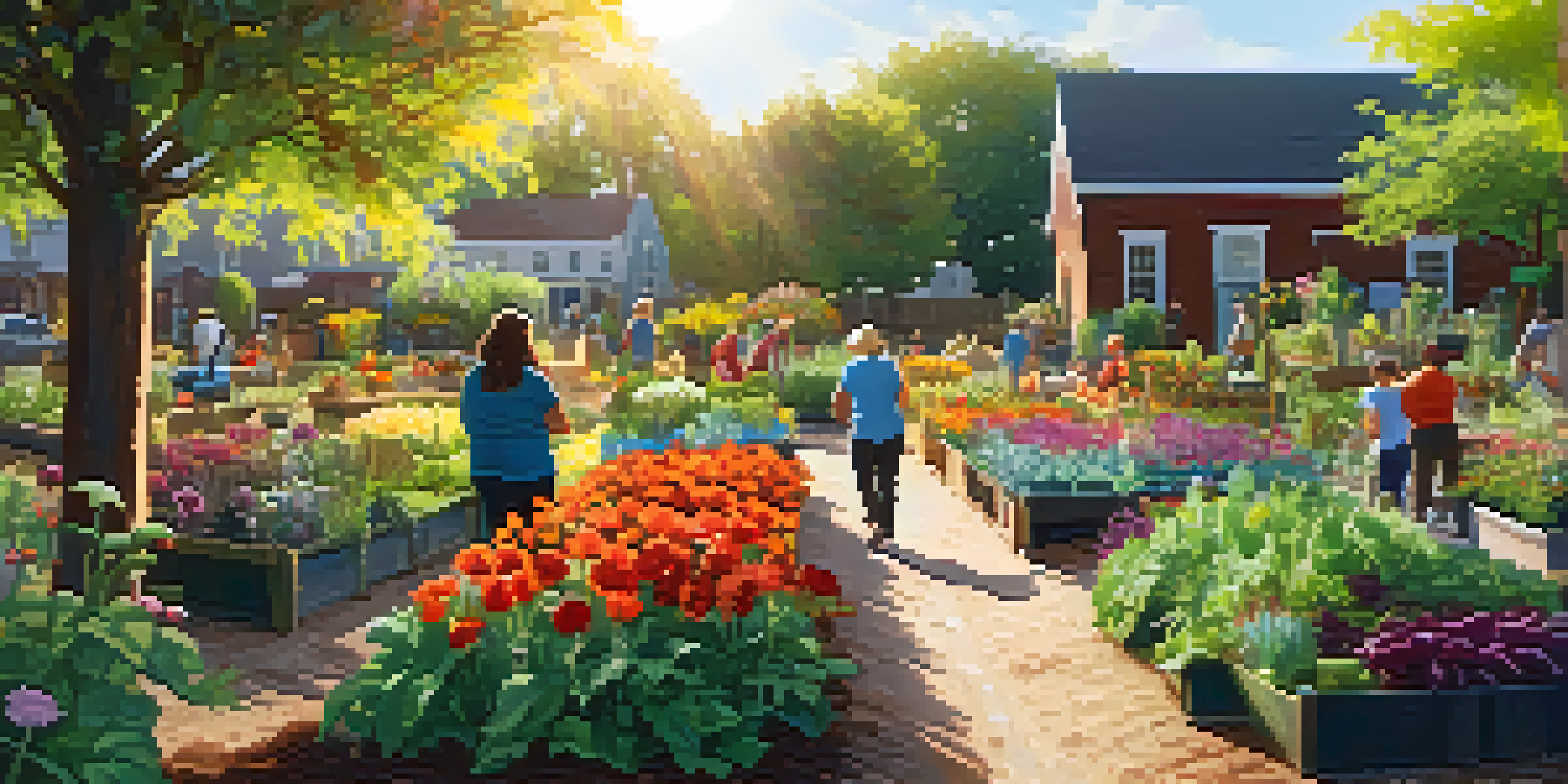Community Gardens: Enhancing Biodiversity in Urban Areas

What Are Community Gardens and Their Importance?
Community gardens are shared spaces where individuals come together to grow plants, vegetables, and flowers. They serve as a vital resource in urban areas, providing fresh produce and green spaces. Beyond their agricultural benefits, these gardens foster community bonds and enhance local ecosystems.
The greatest threat to our planet is the belief that someone else will save it.
By transforming vacant lots or underutilized spaces into vibrant gardens, communities can reclaim areas that might otherwise contribute to urban blight. These gardens not only beautify neighborhoods but also create a sense of ownership and pride among residents. Engaging in gardening activities encourages social interaction and strengthens ties among diverse groups.
Moreover, community gardens play a pivotal role in promoting environmental sustainability. They provide habitats for various species, contributing to urban biodiversity. This collective effort nurtures not just plants but also a thriving community spirit.
The Role of Biodiversity in Urban Ecosystems
Biodiversity refers to the variety of life in a particular habitat, including the different species of plants and animals. In urban areas, increased biodiversity leads to healthier ecosystems, which can improve air and water quality. Community gardens serve as mini-ecosystems, hosting various organisms that contribute to overall environmental health.

For instance, by planting a variety of flowers and vegetables, gardeners attract pollinators like bees and butterflies. These creatures are essential for plant reproduction, which in turn supports food production. The presence of diverse species also helps control pests naturally, reducing the need for chemical interventions.
Community Gardens Boost Food Security
By providing fresh produce and fostering healthy eating habits, community gardens help combat food deserts in urban areas.
Additionally, a biodiverse environment can make urban areas more resilient to climate change. Diverse plant species can withstand extreme weather conditions better than monocultures, ensuring that gardens continue to thrive even in challenging climates. This adaptability is crucial for the sustainability of urban green spaces.
How Community Gardens Foster Local Wildlife
Community gardens act as vital sanctuaries for local wildlife, providing food and shelter amidst the concrete jungle. Birds, insects, and even small mammals find refuge in these spaces, creating a more balanced ecosystem. This interaction between flora and fauna enriches the garden environment, showcasing nature’s beauty in urban settings.
To plant a garden is to believe in tomorrow.
For example, by incorporating native plants, gardeners can attract species that are essential for pollination and seed dispersal. These native plants are often more resilient and require less maintenance compared to non-native species. Thus, gardeners not only support local wildlife but also cultivate a sustainable gardening practice.
Moreover, the presence of wildlife in community gardens can enhance the gardening experience for participants. Observing birds and butterflies can be a delightful reminder of nature’s presence, encouraging individuals to connect with their surroundings. This connection fosters a deeper appreciation for biodiversity and the role each species plays in the ecosystem.
Educating the Community on Environmental Stewardship
Community gardens serve as a platform for environmental education, teaching participants about sustainable practices and the importance of biodiversity. Workshops and hands-on activities can provide valuable knowledge about growing food, composting, and conserving resources. This education empowers individuals to make environmentally conscious decisions.
Children and adults alike benefit from learning in a garden setting. They gain practical skills while cultivating an understanding of nature's cycles and the importance of caring for the environment. Such initiatives can inspire the next generation to prioritize sustainability and actively participate in community efforts.
Biodiversity Enhances Urban Ecosystems
Community gardens act as mini-ecosystems that promote biodiversity, improving air and water quality while supporting local wildlife.
In essence, community gardens are not just about growing plants; they’re about nurturing a culture of stewardship. By fostering a sense of responsibility for the environment, these spaces help create informed citizens who are more likely to advocate for biodiversity and sustainability in their daily lives.
Promoting Food Security Through Urban Gardening
Food security is a pressing issue in many urban areas, and community gardens play a crucial role in addressing this challenge. By providing access to fresh fruits and vegetables, these gardens can help reduce food deserts—areas with limited access to affordable and nutritious food. This access is especially important for low-income families.
Community gardens not only supply food but also encourage individuals to learn about nutrition and healthy eating habits. Participants can cultivate their own produce, which fosters a sense of ownership and appreciation for the food they consume. This hands-on experience can lead to healthier lifestyle choices for individuals and families alike.
Furthermore, the social aspect of community gardening can enhance food security efforts. By sharing the harvest, community members can create a supportive network where food is exchanged and shared. This collaboration strengthens community ties while ensuring that everyone has access to healthy food options.
Mitigating Urban Heat Islands with Green Spaces
Urban heat islands (UHIs) are areas within cities that experience higher temperatures than their rural surroundings, largely due to human activities and infrastructure. Community gardens can help mitigate this effect by introducing greenery and natural cooling systems. The plants absorb sunlight and provide shade, lowering the surrounding temperature.
In addition to cooling, these gardens also improve air quality by filtering pollutants and producing oxygen. The presence of greenery can lead to a healthier urban environment, benefiting both residents and local wildlife. As temperatures continue to rise due to climate change, the role of community gardens in urban planning becomes increasingly significant.
Gardens Promote Community Engagement
These shared spaces not only beautify neighborhoods but also strengthen community bonds through collective gardening efforts.
Moreover, by promoting green spaces, cities can enhance their overall livability. Community gardens create inviting spaces for relaxation and recreation, encouraging residents to spend more time outdoors. This connection to nature can improve mental health and foster a greater appreciation for the urban environment.
The Future of Community Gardens and Urban Biodiversity
As cities continue to grow, the importance of community gardens in enhancing urban biodiversity will only increase. These spaces offer a unique opportunity to create green corridors that connect different habitats, allowing wildlife to thrive. The future of urban landscapes depends on the integration of nature into our city planning.
Innovative approaches, such as vertical gardens and rooftop farming, are also emerging as ways to maximize urban space while promoting biodiversity. These initiatives can help bridge the gap between urban living and nature. Community gardens will continue to play a vital role in this evolution, adapting to meet the needs of urban dwellers and wildlife alike.

Ultimately, the success of community gardens relies on community involvement and support. By fostering a culture of gardening and environmental stewardship, cities can cultivate vibrant ecosystems that benefit both residents and the planet. The future is bright for community gardens as they pave the way for a greener, more sustainable urban environment.